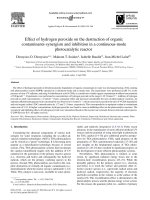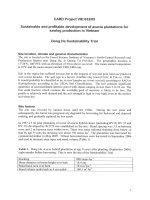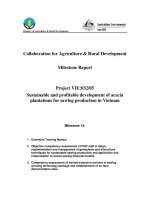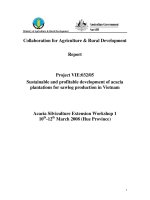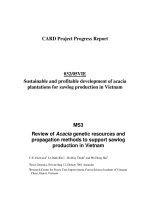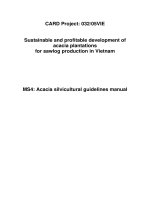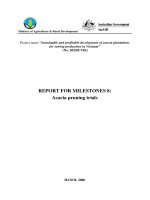STUDIES ON RECYCLING USE OF ORGANIC WASTES FOR SUSTAINABLE AGRICULTURE IN VIETNAM
Bạn đang xem bản rút gọn của tài liệu. Xem và tải ngay bản đầy đủ của tài liệu tại đây (3.71 MB, 86 trang )
STUDIES ON RECYCLING USE OF ORGANIC WASTES
FOR SUSTAINABLE AGRICULTURE IN VIETNAM
ベトナム農業の持続的発展のための有機性廃棄物リサイク
ル利用に関する研究
2018, September
HOANG THI QUYNH
Graduate School of Environmental and Life Science
(Doctor’s Course)
OKAYAMA UNIVERSITY
CONTENTS
ACKNOWLEDGEMENTS......................................................................................................... i
ABSTRACT ................................................................................................................................. ii
LIST OF TABLES ...................................................................................................................... vi
LIST OF FIGURES................................................................................................................... vii
CHAPTER 1. INTRODUCTION .............................................................................................. 1
1.1 Background ........................................................................................................................ 1
1.2 Objectives ........................................................................................................................... 3
1.3 Outline ................................................................................................................................ 3
References ................................................................................................................................ 6
CHAPTER 2. EFFICACY OF COMPOSTED ORGANIC WASTES WHEN APPLIED IN
CONCERT WITH CHEMICAL FERTILIZER ...................................................................... 8
Abstract .................................................................................................................................... 8
2.1 Introduction ....................................................................................................................... 9
2.2 Materials and Methods ................................................................................................... 10
2.2.1 Compost sampling .................................................................................................... 10
2.2.2 Cultivation experiment............................................................................................. 10
2.2.3 Sampling and analysis .............................................................................................. 13
2.3 Results and Discussion .................................................................................................... 13
2.3.1 Effect of compost on crop productivity................................................................... 13
2.3.2 Dynamics of compost-N amended soil .................................................................... 14
2.4 Conclusion........................................................................................................................ 18
References .............................................................................................................................. 19
CHAPTER 3. “ORGANIC FERTILIZERS” IN VIETNAM............................................. 22
Abstract .................................................................................................................................. 22
3.1 Introduction ..................................................................................................................... 23
3.2 Materials and Methods ................................................................................................... 24
3.2.1 Sampling and chemical analysis .............................................................................. 24
3.2.2 Investigation of the flow of raw materials and manufacturing process of an
“organic fertilizer” ............................................................................................................ 25
3.2.3 Cultivation experiment............................................................................................. 26
3.3 Results and Discussion .................................................................................................... 28
3.3.1 Characteristics of “organic fertilizers”................................................................... 28
3.3.2 Production method of an “organic fertilizer” from coffee by-products .............. 36
3.3.3 Effects of “organic fertilizers” on plant growth and N leaching .......................... 37
3.4 Conclusions and Implications......................................................................................... 43
Supplementary materials...................................................................................................... 45
References .............................................................................................................................. 46
CHAPTER 4. RAPID ON-FARM COMPOSTING OF COFFEE BY-PRODUCTS AND ITS
USE AS A FERTILIZER .......................................................................................................... 51
Abstract .................................................................................................................................. 51
4.1 Introduction ..................................................................................................................... 52
4.2 Materials and Methods ................................................................................................... 54
4.2.1 Coffee by-products and bulking agent.................................................................... 54
4.2.2 Composting facilities ................................................................................................ 54
4.2.3 Sampling and analysis .............................................................................................. 55
4.2.4 Cultivation experiment............................................................................................. 56
4.3 Results .............................................................................................................................. 59
4.3.1 Physicochemical properties of finished composts .................................................. 59
4.3.2 Effects of the composts application on plant growth............................................. 59
4.4 Discussion ......................................................................................................................... 63
4.4.1 Quality of finished composts.................................................................................... 63
4.4.2 Applicability in Vietnam .......................................................................................... 65
References .............................................................................................................................. 66
CHAPTER 5. IMPLICATIONS AND FURTHER WORK................................................... 70
APPENDIX ................................................................................................................................ 71
ACKNOWLEDGEMENTS
First and foremost, I would like to express my sincere gratitude to my supervisor Professor Shima
Kazuto for his guidance and support. My sincere thanks also goes to my co-supervisor, Professor
Keiji Sakamoto and Professor Muneto Hirobe.
In addition, I am very grateful to the Japanese Ministry of Education, Culture, Sports, Science,
and Technology (MEXT) for giving a scholarship to conduct the study. I am also grateful the
Research Grant for Encouragement of Students, Graduate School of Environmental and Life
Science, Okayama University, Japan for supporting in my publications.
I would like to thank the anonymous reviewers, the editors and colleagues for their valuable
comments on my manuscripts.
Thanks all lab-mates of the Laboratory of Environmental Soil Science, Okayama University
for their help in doing experiments and emotional support. Special thanks go to Mr. Vo Trung Tin,
the director of Hope Land Vietnam Co., ltd for his strongly support in the consultation and survey
in Lam Dong provice, Vietnam. Thanks to all those who have helped me directly and indirectly
in the successful completion of my study.
Last but not least, I would like to thank my beloved family for their immeasurable support and
love. Thank you very much!
Okayama, 2018
Hoang Thi Quynh.
I
ABSTRACT
The use of recycled organic wastes as fertilizer has gained attention because of a variety of reasons.
Among others, the need to find a sink for the growing amount of wastes and the necessity to
reduce soil exposure to degradation and other negative effects of the use of conventional chemical
fertilizers, are the factors that are most crucial. In Vietnam, different kinds of fertilizers that are
labeled as “organic fertilizer” are available; however, as the raw material and manufacturing
process are poorly regulated, their quality has yet not been fully explored. Organic fertilizer has
the potential to improve the physico-chemical properties of the soil and minimize groundwater
contamination by nutrient leaching. Under the Asian monsoon climate, loss of applied N due to
leaching is excessive due to the high frequency of heavy rainfall. In order to promote the use of
recycled organic wastes as fertilizer in Vietnam, the objectives of this dissertation are three-fold:
(1) to evaluate organic waste-based fertilizers with an emphasis on the nitrogen dynamics of the
plant-soil system, (2) to demonstrate an on-farm rapid composting method, and (3) to make
suggestions regarding the recycling of organic waste and the utilization of organic fertilizers under
humid tropical climates.
To clarify the efficacy of composted organic wastes as fertilizer, a cultivation experiment using
the technique of 15N labeling was conducted in sandy loam-textured soil in a greenhouse.
Composted municipal solid waste (MSW), sewage sludge (SS), and cow dung (CD) were applied
as the basal fertilizer, while 15N labeled urea was applied 4 weeks after planting, as an additional
fertilizer. There were no significant differences in the shoot dry weight among the MSW, SS, and
chemical fertilizer treatments. The uptake of N from the compost by the plants was as follows:
MSW (39.4%) = SS (39.6%) > CD (17.1%). Meanwhile, approximately 4.0% of the N derived
from the urea-N fertilizer was assimilated by the plants. Approximately two-thirds of the urea-N
II
fertilizer was lost by leaching while half of the N derived from the compost remained in the soil
after 14 weeks of cultivation. As the efficacy of the compost might depend on the type of raw
material and composting technique, the following investigations were carried out to verify the
effects of these factors on the quality of the finished compost.
To investigate the quality of the “organic fertilizers” which are being sold in Vietnam’s markets,
16 products (12 domestic and 4 imported) were acquired from 4 provinces of Vietnam. On these
fertilizers, the nutrient contents were analyzed and experiments were conducted. A 20-day
incubation experiment involving 80 g sandy-textured soil mixed with the fertilizer at a rate of
109.4 mg N kg−1 soil was performed in 150 cm3 glass bottles at 25°C in the dark. In addition,
komatsuna (Brassica rapa var. perviridis) was cultured in sandy-textured soil using some typical
“organic fertilizers” applied at a rate of 200 mg N kg−1 soil in a greenhouse. The nutrient content
greatly varied among the domestic products, whereas there were some similarities observed
between the imported products. Two-thirds of the domestic products contained over 30% of the
total N in the inorganic form, implying that the concentration of the inorganic N dramatically
increased in some products rather than in their supposed raw materials. The remarkably high ratio
of the inorganic N to the total N was attributed to the excessive N leaching from the soil by the
application of domestic fertilizers.
As the product label contained insufficient information and therefore, the comparison could not
be drawn between the commercial products and the raw materials. To clearly explain the
characteristics of domestic “organic fertilizers,” we further studied the production of one such
“organic fertilizer” made from coffee by-products (the discarded shells of the cherries in the
coffee processing industry). The stages involved in the production were composting, the addition
of extra soil as a bulking agent and the mixing-in of chemical substances to increase the nutrient
content. The analysis of the nutrient levels of the collected samples at each stage indicated that
III
the coffee by-products were nutrient-rich organic material. The total C content was high, up to
423.2 g kg−1, and the N and K contents were 32.80 g kg−1 and 9.71 g kg−1, respectively. After
composting, a slight decrease was observed in the C content but the concentration of the total N
and K showed an increase. The compost was found to contain 34.8 g kg−1 of N and 12.54 g kg−1
of K. After increasing the bulk of the compost with extra soil, the total C, N, and K contents
reduced to 83.20, 6.40, and 4.48 g kg−1, respectively. However, at the time of shipment, it was
observed that the total N content nearly doubled from 6.40 to 11.20 g kg−1, while the total P
content tripled from 0.99 to 2.99 g kg−1. These observations provide evidence to confirm that the
addition of chemical material is typically the final step in the production of organic waste-based
fertilizers in Vietnam.
Moreover, being the second largest coffee-producing country worldwide, Vietnam is estimated
to generate approximately 1 million m3 of coffee pulp (coffee by-products of wet processing)
annually. Instead of being effectively utilized in the form of recycling resources, most of the waste
is discarded, causing serious environmental pollution even though it contains essential
macronutrients in high concentrations. This large volume of organic waste is mainly generated
during the months of the harvesting season. Additionally, it is difficult to store this material
because of its high moisture content. On the other hand, for a long time, farmers have mainly used
chemical fertilizers instead of organic fertilizers, resulting in soil degradation. Therefore, a simple
method of rapid on-farm composting is the need of the hour to establish a system for recycling
organic waste for sustainable agriculture. Five on-farm small-scale composting trials of coffee
pulp were performed to examine the feasibility of the composting process with bulking agents
under different aerobic conditions. After 2 months of composting, samples were collected for
analysis and a cultivation experiment was conducted to clarify the effectiveness of the composts.
The total C, N, and K contents of the composts were in the range of 340.35-386.02 g kg-1, 23.80-
IV
36.70 g kg-1, and 18.86-25.13 g kg-1, respectively. In the compost where wood chips were used as
the bulking agent under air flow, exhibited a concentration of inorganic N that was significantly
higher than that of the other composts. This indicates that the most important factor influencing
the composting process is the control of aeration with wood chips and air flow. The plant biomass
corresponding to the composts showed similarity with chemical fertilizers. Additionally, the
fertilizer effect depended on the type of soil. Furthermore, the P content and the plants produced
by the compost in which chicken manure was added, were investigated. The results obtained
clearly indicate that the addition of P-sources as manure in the manufacturing process enhanced
the fertilizing efficiency of the compost. However, replications were not included in separate
composting trials; thus, further work is required to understand the optimum conditions of
composting.
These results suggest the need for quality criteria and guidelines for organic fertilizers in
Vietnam that not only specify the nutrient levels, but also control the raw materials used and the
manufacturing process. Production of coffee pulp composting within 2months might be a feasible
method to recycle coffee pulp into good-quality organic fertilizer. The majority of N in the self-
make compost was in the organic form, requiring an enhancement to make it available to plants.
In this regard, urea might have a role to play in enhancing the N mineralization of organic-N in
compost when applied together. Under humid tropical climates, a combined application of
compost and urea with lower amount of applied urea might extend the benefits. Further field
experiment is required to evaluate the effectiveness of this suggestion.
V
LIST OF TABLES
Table 2.1 Chemical properties of the materials.
Table 3.1 pH and nutrient contents (g kg-1) of soil used in the cultivation experiment.
Table 3.2 pH, C: N ratio and concentration of other nutrients in the so-called organic fertilizers
in Vietnam's markets.
Table 3.3 General available information on collected samples.
Table 3.4 Changes in the nutrient levels during the production of the “organic fertilizer”.
Table 3.5 Two-way analysis of variance (ANOVA) testing the effects of fertilizer type and
nutritional supplementation on dry weight of plants.
Table 3.6 Two-way analysis of variance (ANOVA) testing the effects of fertilizer type and
nutritional supplementation on N uptake.
Table 3.7 Two-way analysis of variance (ANOVA) testing the effects of fertilizer type and
nutritional supplementation on P uptake.
Table 3.8 Dry weight and nutrients uptake of treatments.
Table 4.1 Moisture content (%) and nutrient content (g kg-1) of the materials.
Table 4.2 Materials and condition of composting trials.
Table 4.3 pH and nutrient content of soils used in the cultivation experiment.
Table 4.4 pH and nutrient content of finished composts influenced by composting trials.
Table 4.5 Two-way analysis of variance testing the effects of soil types and applied fertilizers on
dry weight of plants.
VI
LIST OF FIGURES
Fig. 1.1 The nitrogen cycle and human management of soils
Fig. 1.2 An outline of the thesis
Fig. 2.1 A diagram of the experimental setup.
Fig. 2.2 A picture of the cultivation system.
Fig. 2.3 Changes in shoot length at the first harvest as influenced by different treatments.
Fig. 2.4 Shoot dry weight as influenced by different treatments.
Fig. 2.5 N dynamics of basal fertilizer (Basal) and additional fertilizer (Add.) as influenced by
different treatments.
Fig. 3.1 N content of “organic fertilizers” in Vietnam's markets.
Fig. 3.2 P content of the “organic fertilizers” in Vietnam's markets.
Fig. 3.3 K content of the “organic fertilizers” in Vietnam's markets.
Fig. 3.4 Relationship between total N and P of the “organic fertilizers”.
Fig. 3.5 Flow of raw materials and production method of an “organic fertilizer” from coffee by-
products.
Fig. 3.6 Correlation between N leaching and ratio of inorganic N to total N in the fertilizers.
Fig. 3.7 Relationship between dry weight of plants and N leaching
Fig. 4.1 Schematic diagram of the composting system.
Fig. 4.2 Moisture content of finished compost influenced by composting trials.
Fig. 4.3 Inorganic N of finished compost influenced by composting trials.
Fig. 4.4 P content of finished compost influenced by composting trials.
Fig. 4.5 Plant biomass influenced by the fertilizer treatments and soil types.
VII
CHAPTER 1. INTRODUCTION
1.1 Background
The use of recycled organic wastes as fertilizer have been paid attention because of variety of
reasons. Among others, the need to find a sink for the growing amounts of the wastes, the
necessity to reduce soil exposure to degradation and the use of conventional chemical fertilizers,
are the factors that are the most crucial.
The amount of organic materials from agro-industrial and municipal origins have been
increased, and thus their storage problem has appeared. In the developed countries, day-to-day
generation of enormous quantities of municipal solid waste (MSW) has brought the sanitary
landfills and other MSW handling facilities to the limits of their capacity. In developing world,
agricultural by-products are often burned in the open air to generate fertilizer in the form of ash,
but this not only destroy a great deal of carbon and other nutrients but also is a source of air
pollution and global warming. MSW strewn almost everywhere of most developing countries (S.
Gajalakshmi and S. A. Abbasi, 2008; C. Edward et al., 2007). For sustainable development, those
so-called wastes must be recycled and composting appears to be an attractive alternative.
Organic fertilizer has the potential to improve the physico-chemical properties of the soil and
to minimize groundwater contamination by nutrient leaching. Since the end of World World II
famers have markedly increased the use of chemical fertilizers in place of organic fertilizers and
amendments. Soils in many parts of the world are increasingly stressed from long-term cultivation
and the resulting losses of soil carbon, loses of soil productivity (C. Edward et al., 2007). Carbon
lost from the soil must be replaced by crop residues or organic amendments. The application of
compost increased soil fertility and decreased nutrient leaching (M. Mamo et al., 1998;
Mohammad et al., 2007; Paul et al., 2009).
1
Since the majority of N of organic fertilizers is organic form, requiring an enhancement of
plant-available N. Organic N in organic fertilizers must be mineralized before plants can use or it
becomes susceptible to loss as N leaching. The N mineralization depends on many factors such
as compost quality parameters, soil properties and application rate and time. So, it is necessary to
have site-specific study to get accurate prediction of N crop requirement and potential N leaching
(Florian et al., 2003). The fate of N applied via fertilizer is relevant not only to plant production
but also to groundwater contamination by N leaching. Under the Asian monsoon climate, the loss
of applied N is excessive (Nguyen et al., 2014).
Fig. 1.1 The nitrogen cycle and human management of soils
( />
2
In Vietnam, one of the most striking problems is the widespread soil degradation in agricultural
areas, requiring the use of the land in a more sustainable manner (Vu et al., 2014; Shima et al.,
2015; Tran et al., 2015). An improved land tenure security is associated with a higher level of
manure use by farm households (Nguyen et al., 2016). There are a lot of different kinds of
fertilizers labeled as “organic fertilizer” are being sold in the markets; however, with the
manufacture being poorly regulated, their quality has not been fully explored. On the other hand,
composting is not a common practice and farmers do not make the best use of organic recycling
opportunities available to them due to lack of efficient expeditious technology.
1.2 Objectives
The objectives of this dissertation are three-fold: (1) to evaluate organic waste-based fertilizers
with an emphasis on the nitrogen dynamics of the plant-soil system, (2) to demonstrate an on-
farm rapid composting method, (3) to make suggestions regarding the recycling organic waste
and the utilization of organic fertilizers under humid tropical climates.
1.3 Outline
The outline of thesis is presented in figure 1.2. Chapter 1 introduces the necessity of using
recycled organic wastes as fertilizer and related issues. The chapter also states the objectives and
the outline of thesis. Chapter 2 presents the efficacy of using composted organic wastes as
fertilizer when applied in concert with chemical fertilizer. Under humid tropical climates, how
organic fertilizers provide advantages over chemical fertilizers? To investigate this question, a
cultivation experiment using the technique of 15N labelling was conducted. There were no
significant differences in shoot dry weight among the composts and chemical fertilizer treatments.
3
Approximately two-thirds of the urea-N was lost by leaching while half of N derived from
composts remained in the soil after 14 weeks cultivation. The following chapter focusses on so-
called organic fertilizers in Vietnam’s markets. What is “organic fertilizer” in Vietnam? Is it
effective? To investigate these questions, 16 commercial products were acquired from 4 provinces
of Vietnam. On these fertilizers, the nutrient composition were analyzed and experiments were
conducted: incubation experiment to evaluate N mineralization rate of the fertilizers, and a
cultivation experiment to assess the effects of the fertilizers on plant and N leaching. The nutrient
content greatly varied among domestic products, whereas they were quite similar among imported
products. The remarkably high ratio of inorganic N to total N in domestic products was attributed
to excessive N leaching from soil. Why domestic “organic fertilizers” differ from the other? As
the product packaging of the collected samples lacked information regarding raw materials, the
comparison could not be drawn between the commercial products and their supposed raw
materials. And therefore, an investigation the production of one such “organic fertilizer” was
carried on. The involved stages were composting, the addition of extra soil as a bulking agent,
and the mixing-in of chemical substances to increase the nutrient content. For sustainable
agriculture, the use of these fertilizers should be considered. Chapter 4 proposes a simple method
of composting to establish recycling of organic waste for sustainable agriculture in Lam Dong
province of Vietnam. On-farm small-scale composting trials of coffee by-products were
performed. After 2 months composting, samples were taken for analysis and cultivation
experiment. Total C, N and K contents of composts were in the range of 340.35-386.02 g.kg-1,
23.80-36.70 g.kg-1, and 18.86-25.13 g.kg-1, respectively. In the compost where wood chips were
used as the bulking agent under air flow, exhibited a concentration of inorganic N that was
significantly higher than that of the other composts. It indicated that the most important factor
influencing composting process was the control of aeration with wood chips and air flow. The
4
plant biomass corresponding to composts showed similarity with chemical fertilizer. Finally,
some implications and further work are presented in chapter 5.
Fig. 1.2 An outline of the thesis
5
References
[1] C. Edward Clapp, Michael H. B. Hayes, and Claudio Ciavatta (2007). Organic waste in soils:
Biogeochemical and environmental aspects. Soil Biology & Biochemistry, vol. 39, 1239-1243.
[2] Florian Amlingera, Bettina Götzb, Peter Dreherc, Jutta Gesztia, and Christof Weissteinera
(2003). Nitrogen in bio-waste and yard waste compost: dynamics of mobilization and
availability - a review. European Journal of Soil Biology, vol. 39, pp. 107-116, 2003.
[3] M. Mamo, C.J. Rosen, T. R. Halbach (1998). Nitrogen availability and leaching from soil
amended with municipal solid waste compost. Environmental Quality, vol. 28 (4), 1074-1082.
[4] Mohammad H. Golabi, M.J. Denney and Clancy Iyekar (2007). Value of composted organic
waste as an alternative to synthetic fertilizers for soil quality improvement and increased yield.
Compost Science & Utilization, vol. 15, issue 4.
/>
[5] Paul Hepperly, Don Lotter, Christine Ziegler Ulsh, Rita Seidel, Carolyn Reider (2009).
Compost, manure and synthetic fertilizer influences crop yields, soil properties, Nitrate
leaching and crop nutrient content. Compost Science & Utilization, vol. 17, issue 2.
/>
[6] Quyet Manh Vu, Quang Bao Le, Emmanuel Frossard, Paul L.G.Vlek (2014). Socio-economic
and biophysical determinants of land degradation in Vietnam: An integrated causal analysis
at the national level. Land Use policy, vol. 36, 605-617.
/>
[7] Tran Minh Tien. Vietnam soil resources. Presented at the Asian Soil Partnership Consultation
Workshop on Sustainable Management and Protection of Soil Resources, Bangkok, 13-15
May, 2015. />
(April, 2018)
6
[8] Trung Thanh Nguyen, Marianne Ruidisch, Thomas Koellner, JohnTenhunen (2014).
Synergies and tradeoffs between nitrate leaching and net farm income: The case of nitrogen
best management practices in South Korea. Agriculture, Ecosystems & Environment, vol. 186,
160-169.
[9] Trung Thanh Nguyen, Siegfried Bauer; Ulrike Grote (2016). Does land tenure security
promote manure use by farm households in Vietnam? Sustainability, 8(2), 178.
/>
[10] Shima Kazuto, Nguyen Thanh Binh, Hoang Thi Quynh, Hayashi Yu. The effects of
land-use change for rubber plantation on physical properties of surface soil in Central
Vietnam. Presented at the Japan – Vietnam Research Workshop on Sustainable Society
Development in Asian Countries Talking Climate Change, 2-3 November, 2015.
[11] S. Gajalakshmi and S. A. Abbasi (2008). Solid waste management by composting: State
of the art. Environmental Science and Technology, 38:311-400.
7
CHAPTER 2. EFFICACY OF COMPOSTED ORGANIC WASTES WHEN APPLIED IN
CONCERT WITH CHEMICAL FERTILIZER
Abstract
Recycling organic waste for agricultural use is gaining interest in Vietnam. This study
investigated the effect of using composted municipal solid waste (MSW) as fertilizer to grow
Sudan grass (Panicum maximum) and compared it with composted sewage sludge (SS),
composted cow dung (CD), and traditional urea-based chemical fertilizer. A cultivation
experiment (using containers) was conducted by growing the grass in sandy loam-textured soil
using an automatic irrigation system in a greenhouse. 15N labeled urea-N was used to distinguish
N (nitrogen) that derived from urea-N or from compost. The various types of compost (MSW, SS,
CD) and urea-N were applied as a basal fertilizer (incorporating into soil), while additional urea-
N fertilizer was applied 4 weeks after planting. There was no significant difference in either grass
shoot length or shoot dry weight among the MSW, SS, and urea-N treatments and their values
were higher than grass grown under the CD treatment. The order of percent N uptake by grass
derived from compost was as follows: MSW (39.4%) = SS (39.6%) > CD (17.1%). In contrast,
approximately 4.0% of N derived from urea-N was assimilated by the grass. Approximately two-
thirds of the urea-N fertilizer was lost by leaching while half of N derived from organic fertilizers
remained in the soil. The amount of leached N from soil decreased in the following order: MSW
= CD > SS. These results provide data needed to support the development programs for organic
waste recycling and agricultural use of organic waste-based fertilizers in Vietnam.
Index Terms Municipal solid waste, sewage sludge, N uptake, leaching, agricultural use,
Vietnam.
8
2.1 Introduction
A large amount of municipal solid waste containing organic carbon and nutrients are produced
daily. In Vietnam, most solid waste is sent to landfills, creating an environmental burden on the
government to find suitable disposal sites. The generation of solid waste increased annually by
10% in period of 2011-2015; that amount is expected to grow rapidly in future years. Municipal
solid waste accounted for 46% of the waste generation with 63 thousand tons daily produced.
Furthermore, the waste has high moisture content and contains a high proportion of organic matter,
ranging from 54.0% to 77.1% across cities [1]-[4]. Therefore, biomass recycling has been gaining
favor as an approach to reduce solid waste in landfills.
Monoculture agricultural practices in humid, tropical climates accelerate soil degradation. In
Vietnam, degraded soil is widespread in agricultural areas. Most soil carbon (in topsoil) is lost
via erosion; therefore, intensely-cultivated soils cannot retain nutrients [5]-[7].
Application of organic matter is recommended for improving soil productivity [8]-[10]. Most
farmers believe that mineral fertilizers are more quickly assimilated by crops than organic
fertilizers; therefore, farmers often apply organic fertilizers to crops at the time of planting (basal
fertilizers) and then apply chemical fertilizers later when needed. However, the efficacy of this
practice requires further study.
Manure is popularly used as an organic fertilizer worldwide. In addition, sewage sludge is
becoming an important recyclable organic material in developing countries that are rapidly
urbanizing [11], [12]. Recently, urban areas in Vietnam have begun to compost their solid waste.
However, regulations on the recycling of organic fertilizers have not been sufficiently established
in Vietnam [13]. Therefore, the development of composting techniques and utilization of compost
has become an important focus of research.
This study focuses on the efficacy of and mechanisms for using composted municipal solid
9

